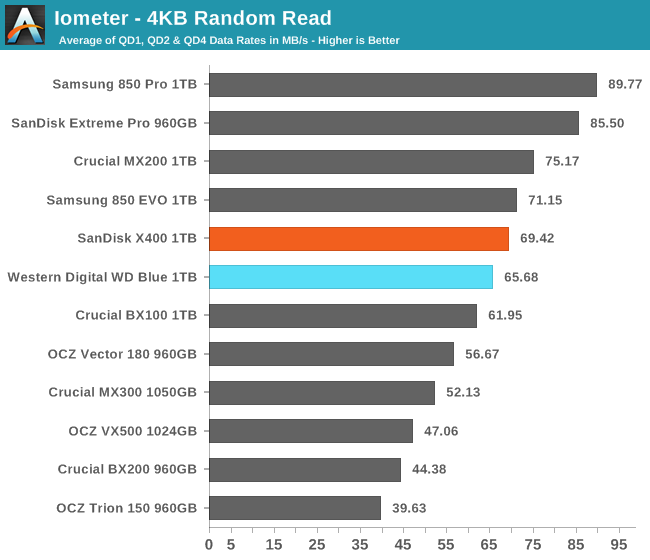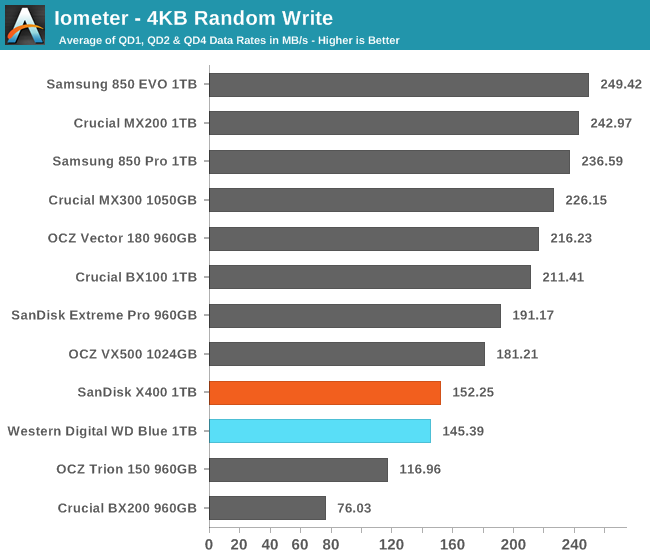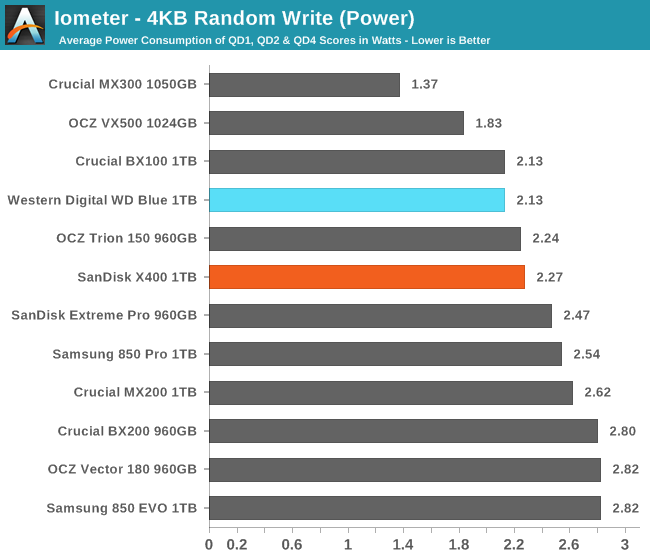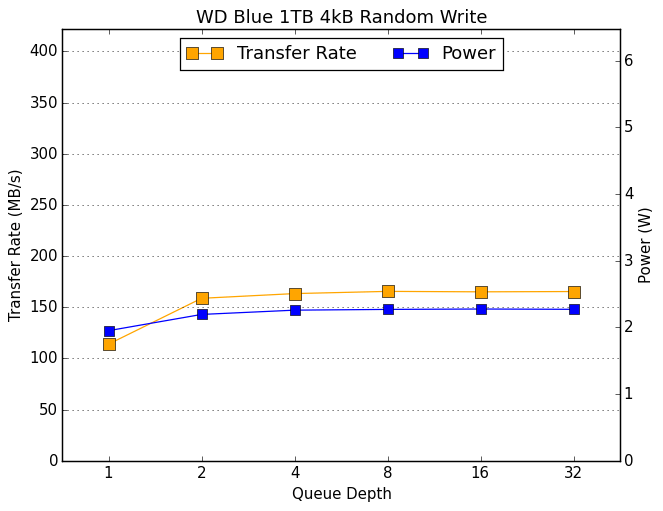The Western Digital Blue (1TB) SSD Review: WD Returns to SSDs
by Billy Tallis on October 11, 2016 8:00 AM EST- Posted in
- SSDs
- Storage
- Western Digital
- SanDisk
Random Read Performance
The random read test requests 4kB blocks and tests queue depths ranging from 1 to 32. The queue depth is doubled every three minutes, for a total test duration of 18 minutes. The test spans the entire drive, which is filled before the test starts. The primary score we report is an average of performances at queue depths 1, 2 and 4, as client usage typically consists mostly of low queue depth operations.

The WD Blue's random read speed is a bit slower than the X400 but the difference is not big enough to change the rankings and it is still above average.

The WD Blue draws slightly less power than the SanDisk X400, which is enough for it to retain efficiency that is good by the standards of planar TLC SSDs.
 |
|||||||||
The WD Blue's random read performance scales well with increasing queue depth, eventually reaching a maximum that is almost as high as the top SATA drives. The performance at QD16 is also notably better than most budget SSDs.
Random Write Performance
The random write test writes 4kB blocks and tests queue depths ranging from 1 to 32. The queue depth is doubled every three minutes, for a total test duration of 18 minutes. The test is limited to a 16GB portion of the drive, and the drive is empty save for the 16GB test file. The primary score we report is an average of performances at queue depths 1, 2 and 4, as client usage typically consists mostly of low queue depth operations.

The SanDisk X400 went a long way toward closing the gap in random write performance between TLC and MLC drives, but a substantial gap still remained. The WD Blue comes in just shy of the X400 but is much faster than the OCZ Trion 150.

The WD Blue doesn't set any overall record for power efficiency, but it does slightly improve on the X400's efficiency and raises the bar for planar TLC.
 |
|||||||||
The WD Blue shows minimal random write performance scaling with queue depth, increasing from QD1 to QD2 but remaining constant thereafter.










75 Comments
View All Comments
TheinsanegamerN - Tuesday, October 11, 2016 - link
it's an interesting drive, but why buy these when the likes of the mushkin reactor are $60 cheaper for the 1TB varient? sata III drives have peaked performance wise.OTOH, cant wait to see what the WD black SSDs look like. 4TB? M.2 PCIE?
dave_the_nerd - Tuesday, October 11, 2016 - link
The Reactor 1TB was a clone of the BX100... which outperformed the WD Blue in a lot of tests here. Getting harder to find them though.Hopefully the street price of this will be more in-line with the rest of the market, price/performance wise.
TheinsanegamerN - Tuesday, October 11, 2016 - link
the only thing this WD drive does better is write endurance. 400TB, or even 320TB for the sandisk version, is a heck of a lot better then the 144TB of the 1TB reactor drive.ammacdo - Tuesday, October 11, 2016 - link
The thing I like most about this review is seeing how well my BX100 still holds up, and I paid the same MSRP this one is going for over a year ago.paulgj - Monday, October 31, 2016 - link
I agree, I bought half a dozen BX100's when they went on sale. Excellent MLC SSDs.Bullwinkle J Moose - Tuesday, October 11, 2016 - link
It depends on the consistency of performance and not the peakThe concern I have is Sandisk consistency of performance which cannot be checked using a single test drive
I have 3 of the Sandisk Extreme Pro thumbdrives that are Windows to Go compatible as they are "Fixed Disks"
One of them is completely unusable after a week, one is so-so and one is very good (performance wise)
The only thing that will return the speed to "Like-New" condition is using Killdisk over the entire drive
The CrapCleaner Drive wipe utility does not return full performance, and the new Defraggler SSD Optimizer does not return full performance
I have not found any method other than Killdisk to temporarily regain full disk performance
Of course, not having Trim or Garbage collection exacerbates the problem which then accelerates the thermal throttling issue
Mushkin also has a bad rep for thermal issues on their Win2Go compatible thumbdrives
The new Corsair GTX beats them all hands down for Windows to go and since my test machine is an older Sandy Bridge for XP compatability, the corsair is actually faster on the USB3 port than my Samsung 850 Pro is on the SATA2 ports
I hope Anandtech can address consistency between identical drives at some point
Bullwinkle J Moose - Tuesday, October 11, 2016 - link
Corsair GTX Thumb drives seem VERY Consistent between drives as wellWwhat - Sunday, October 30, 2016 - link
You seem to be a pretty unique case and not an average user in any way.But it's still an interesting comment I feel. Or I should say 'because of that' rather than 'still'.
Bulat Ziganshin - Saturday, October 15, 2016 - link
they can't build Black from air. sandisk best ssd is extreme pro, so Black will be updated version of itnathanddrews - Tuesday, October 11, 2016 - link
Does this WD SSD come with software to clone/shrink your existing drive to the new SSD? I have an older SiliconEdge Blue 64GB SSD (still working well) and WD offers a utility on their website to do just that, but only if there is a WD drive attached to the machine. I assume this utility would work with this SSD? Not sure if you image your test drives using different tools or what.Samsung has another great utility that comes with a slick SATA-to-USB 3.0 dongle (free in the box) that will clone/shrink any drive to a target Samsung SSD. They go above and beyond the capabilities of Windows volume shrink by a lot.